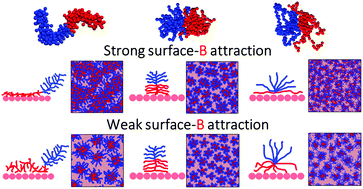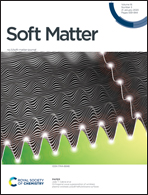Self-assembly of amphiphilic polymers of varying architectures near attractive surfaces†
Abstract
We use coarse-grained molecular dynamics simulations to investigate the assembly of A–B amphiphilic polymers near/on surfaces as a function of polymer architecture and surface attraction to the solvophobic B-block in the polymer. We study four polymer architectures: linear, bottlebrush with a backbone that is longer than each of the side chains, bottlebrush where the solvophobic backbone is similar in length to each of the side chains, and ‘star-like’ architectures where the backbone is significantly shorter than the side chain lengths. For each architecture and surface-B attraction, we quantify the assembled aggregate structure (i.e., aggregation number, domain shapes and sizes) and the chain conformations (i.e., components of the chain radius of gyration) on and away from the surface. For all the architectures and surface-B attraction strengths, the assembled structure away from the surface is similar to the assembly observed in bulk systems without surfaces. Near/on the surface, the assembled B-blocks form domains whose shapes and sizes are dependent on the surface-B attraction strength and the ability of the B-block in the polymer architecture to change conformations and pack on the surface. Domain sizes formed from linear and ‘star-like’ polymer architectures show the highest sensitivity to surface-B-block attraction strength, transitioning from hemispherical to disordered domains with increasing attraction strength. In contrast, bottlebrushes with long backbones and short side chains transition from hemispherical to striped to continuous domains with increasing surface-B attraction strength. Bottlebrushes with similar solvophobic backbone and side chain lengths form hemispherical domains that do not change significantly with the surface-B-block attraction strength. These computational results can guide experimentalists in their choices of surface chemistry and polymer architecture to achieve desired assembled domain shapes and sizes on the surface.



 Please wait while we load your content...
Please wait while we load your content...